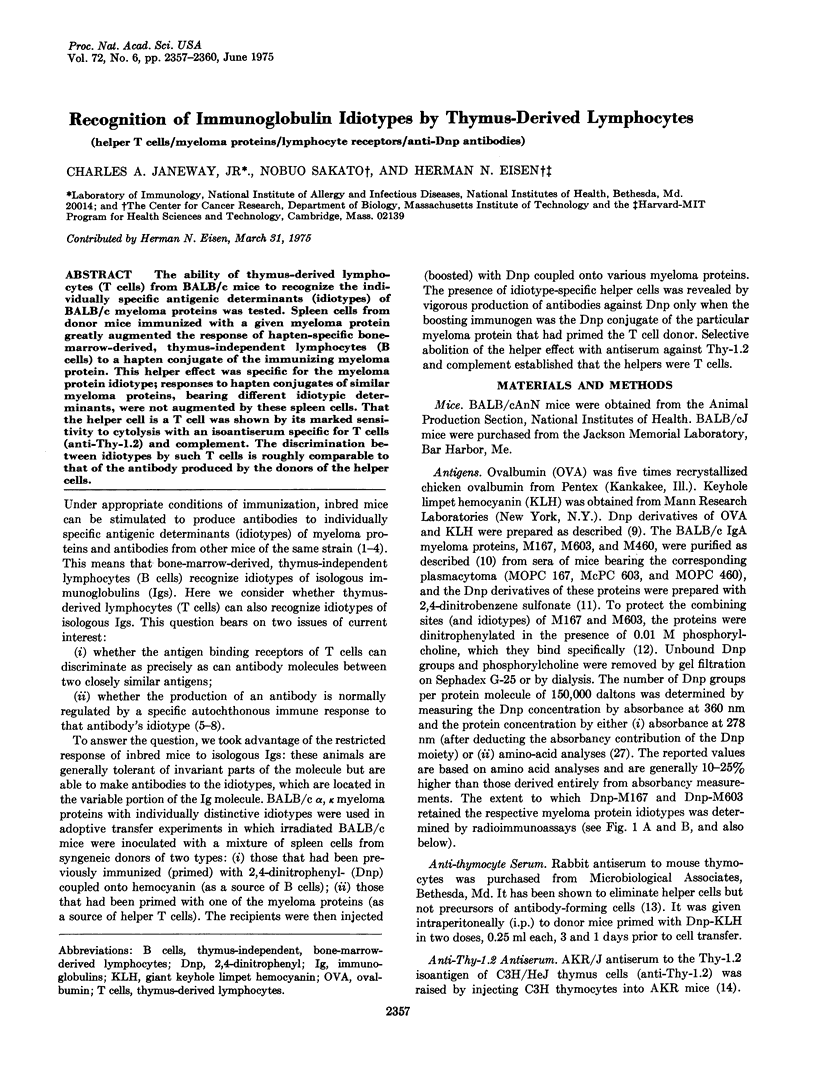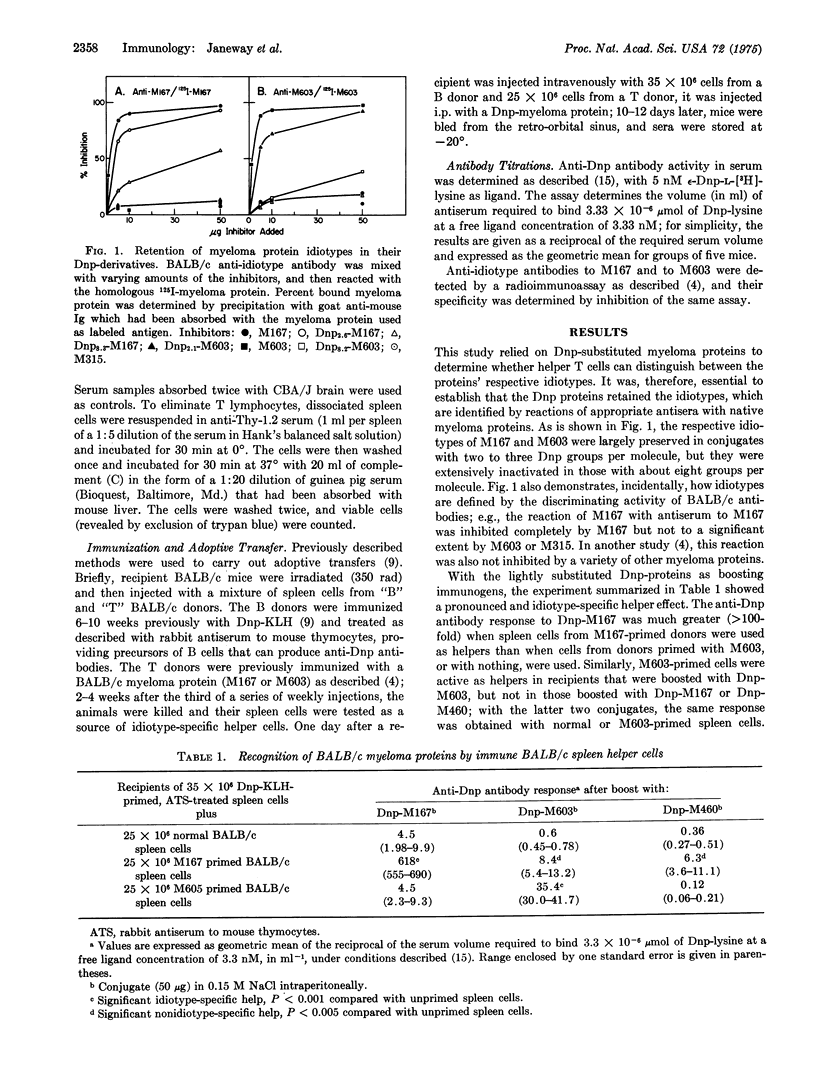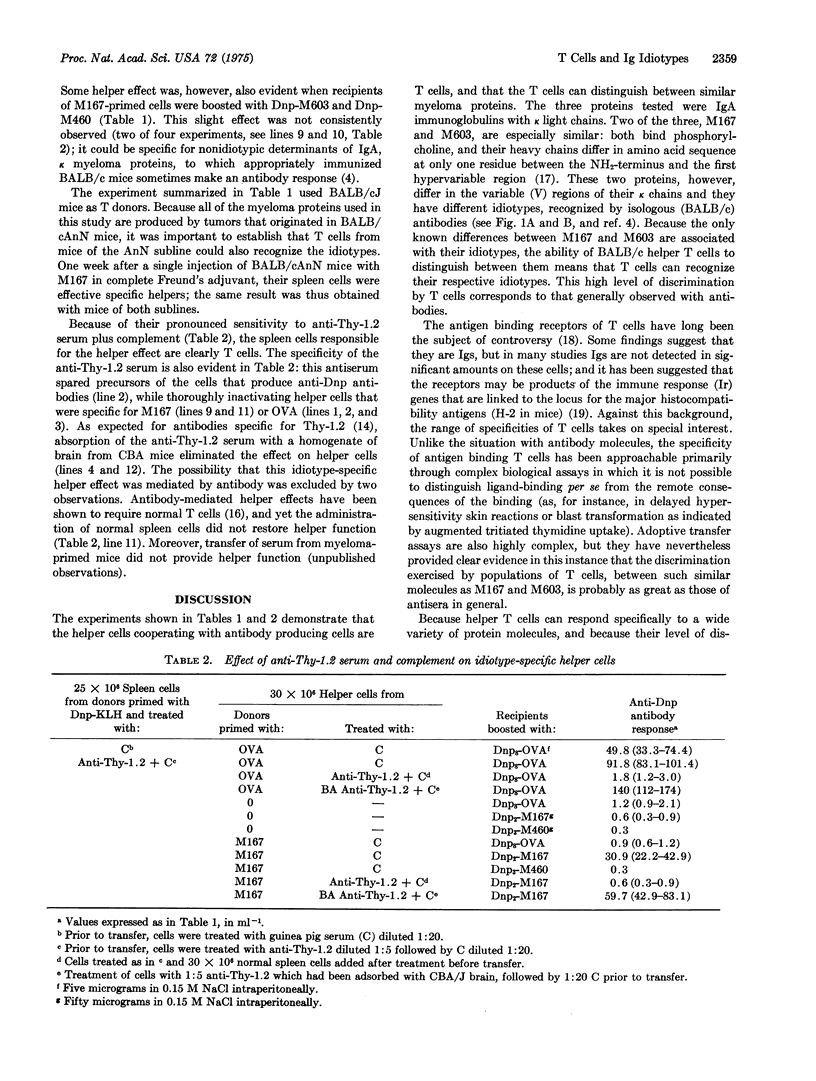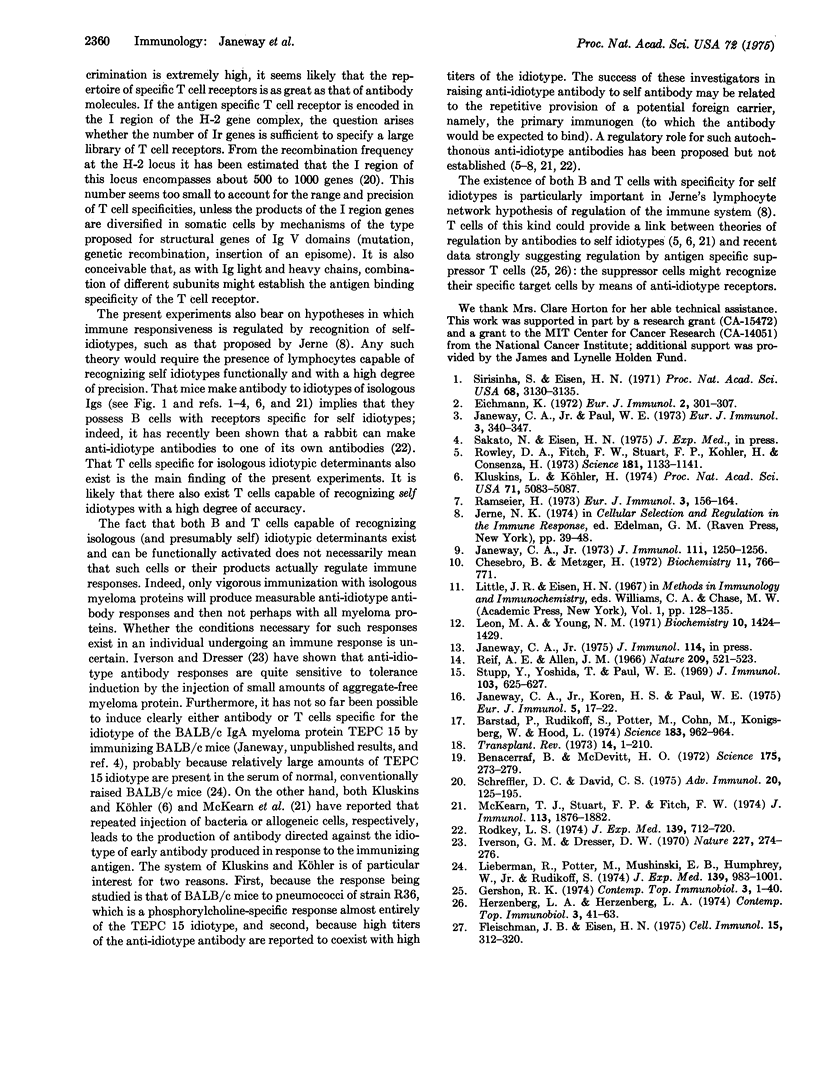Abstract
The ability of thymus-derived lymphocytes (T cells) from BALB/c mice to recognize the individually specific antigenic determinants (idiotypes) of BALB/c myeloma proteins was tested. Spleen cells from donor mice immunized with a given myeloma protein greatly augmented the response of hapten-specific bone marrow-derived, thymus-independent lymphocytes (cells) to a hapten conjugate of the immunizing myeloma protein. This helper effect was specific for the myeloma protein idiotype; responses to hapten conjugates of similar myeloma proteins, bearing different idiotypic determinants, were not augmented by these spleen cells. That the helper cell is a T cell was shown by its marked sensitivity to cytolysis with an isoantiserum specific for T cells (anti-Thy-1-2) and complement. The discrimination between idiotypes by such T cells is roughly comparable to that of the antibody produced by the donors of the helper cells.
Full text
PDF



Selected References
These references are in PubMed. This may not be the complete list of references from this article.
- Barstad P., Rudikoff S., Potter M., Cohn M., Konigsberg W., Hood L. Immunoglobulin structure: amino terminal sequences of mouse myeloma proteins that bind phosphorylcholine. Science. 1974 Mar 8;183(4128):962–966. doi: 10.1126/science.183.4128.962. [DOI] [PubMed] [Google Scholar]
- Benacerraf B., McDevitt H. O. Histocompatibility-linked immune response genes. Science. 1972 Jan 21;175(4019):273–279. doi: 10.1126/science.175.4019.273. [DOI] [PubMed] [Google Scholar]
- Chesebro B., Metzger H. Affinity labeling of a phosphorylcholine binding mouse myeloma protein. Biochemistry. 1972 Feb 29;11(5):766–771. doi: 10.1021/bi00755a014. [DOI] [PubMed] [Google Scholar]
- Eichmann K. Idiotypic identity of antibodies to streptococcal carbohydrate in inbred mice. Eur J Immunol. 1972 Aug;2(4):301–307. doi: 10.1002/eji.1830020402. [DOI] [PubMed] [Google Scholar]
- Fleischman J. B., Eisen H. N. Antigen recognition in delayed-type hypersensitivity. Cell Immunol. 1975 Feb;15(2):312–320. doi: 10.1016/0008-8749(75)90010-6. [DOI] [PubMed] [Google Scholar]
- Gershon R. K. T cell control of antibody production. Contemp Top Immunobiol. 1974;3:1–40. doi: 10.1007/978-1-4684-3045-5_1. [DOI] [PubMed] [Google Scholar]
- Herzenberg L. A., Herzenberg L. A. Short-term and chronic allotype suppression in mice. Contemp Top Immunobiol. 1974;3:41–75. doi: 10.1007/978-1-4684-3045-5_2. [DOI] [PubMed] [Google Scholar]
- Iverson G. M., Dresser D. W. Immunological paralysis induced by an idiotypic antigen. Nature. 1970 Jul 18;227(5255):274–276. doi: 10.1038/227274a0. [DOI] [PubMed] [Google Scholar]
- Janeway C. A., Jr, Koren H. S., Paul W. E. The role of thymus-derived lymphocytes in an antibody-mediated hapten-specific helper effect. Eur J Immunol. 1975 Jan;5(1):17–22. doi: 10.1002/eji.1830050105. [DOI] [PubMed] [Google Scholar]
- Janeway C. A., Jr, Paul W. E. Hapten-specific augmentation of the anti-idiotype antibody response to hapten-myeloma protein conjugates in mice. Eur J Immunol. 1973 Jun;3(6):340–347. doi: 10.1002/eji.1830030605. [DOI] [PubMed] [Google Scholar]
- Janeway C. A., Jr The mechanism of a hapten-specific helper effect in mice. J Immunol. 1973 Oct;111(4):1250–1256. [PubMed] [Google Scholar]
- Kluskens L., Köhler H. Regulation of immune response by autogenous antibody against receptor. Proc Natl Acad Sci U S A. 1974 Dec;71(12):5083–5087. doi: 10.1073/pnas.71.12.5083. [DOI] [PMC free article] [PubMed] [Google Scholar]
- Leon M. A., Young N. M. Specificity for phosphorylcholine of six murine myeloma proteins reactive with Pneumococcus C polysaccharide and beta-lipoprotein. Biochemistry. 1971 Apr 13;10(8):1424–1429. doi: 10.1021/bi00784a024. [DOI] [PubMed] [Google Scholar]
- Lieberman R., Potter M., Mushinski E. B., Humphrey W., Jr, Rudikoff S. Genetics of a new IgVH (T15 idiotype) marker in the mouse regulating natural antibody to phosphorylcholine. J Exp Med. 1974 Apr 1;139(4):983–1001. doi: 10.1084/jem.139.4.983. [DOI] [PMC free article] [PubMed] [Google Scholar]
- McKearn T. J., Stuart F. P., Fitch F. W. Anti-idiotypic antibody in rat transplantation immunity. I. Production of anti-idiotypic antibody in animals repeatedly immunized with alloantigens. J Immunol. 1974 Dec;113(6):1876–1882. [PubMed] [Google Scholar]
- Reif A. E., Allen J. M. Mouse thymic iso-antigens. Nature. 1966 Jan 29;209(5022):521–523. doi: 10.1038/209521b0. [DOI] [PubMed] [Google Scholar]
- Rodkey L. S. Studies of idiotypic antibodies. Production and characterization of autoantiidiotypic antisera. J Exp Med. 1974 Mar 1;139(3):712–720. doi: 10.1084/jem.139.3.712. [DOI] [PMC free article] [PubMed] [Google Scholar]
- Rowley D. A., Fitch F. W., Stuart F. P., Köhler H., Cosenza H. Specific suppression of immune responses. Science. 1973 Sep 21;181(4105):1133–1141. doi: 10.1126/science.181.4105.1133. [DOI] [PubMed] [Google Scholar]
- Shreffler D. C., David C. S. The H-2 major histocompatibility complex and the I immune response region: genetic variation, function, and organization. Adv Immunol. 1975;20:125–195. doi: 10.1016/s0065-2776(08)60208-4. [DOI] [PubMed] [Google Scholar]
- Sirisinha S., Eisen H. N. Autoimmune-like antibodies to the ligand-binding sites of myeloma proteins. Proc Natl Acad Sci U S A. 1971 Dec;68(12):3130–3135. doi: 10.1073/pnas.68.12.3130. [DOI] [PMC free article] [PubMed] [Google Scholar]
- Stupp Y., Yoshida T., Paul W. E. Determination of antibody-hapten equilibrium constants by an ammonium sulfate precipitation technique. J Immunol. 1969 Sep;103(3):625–627. [PubMed] [Google Scholar]


